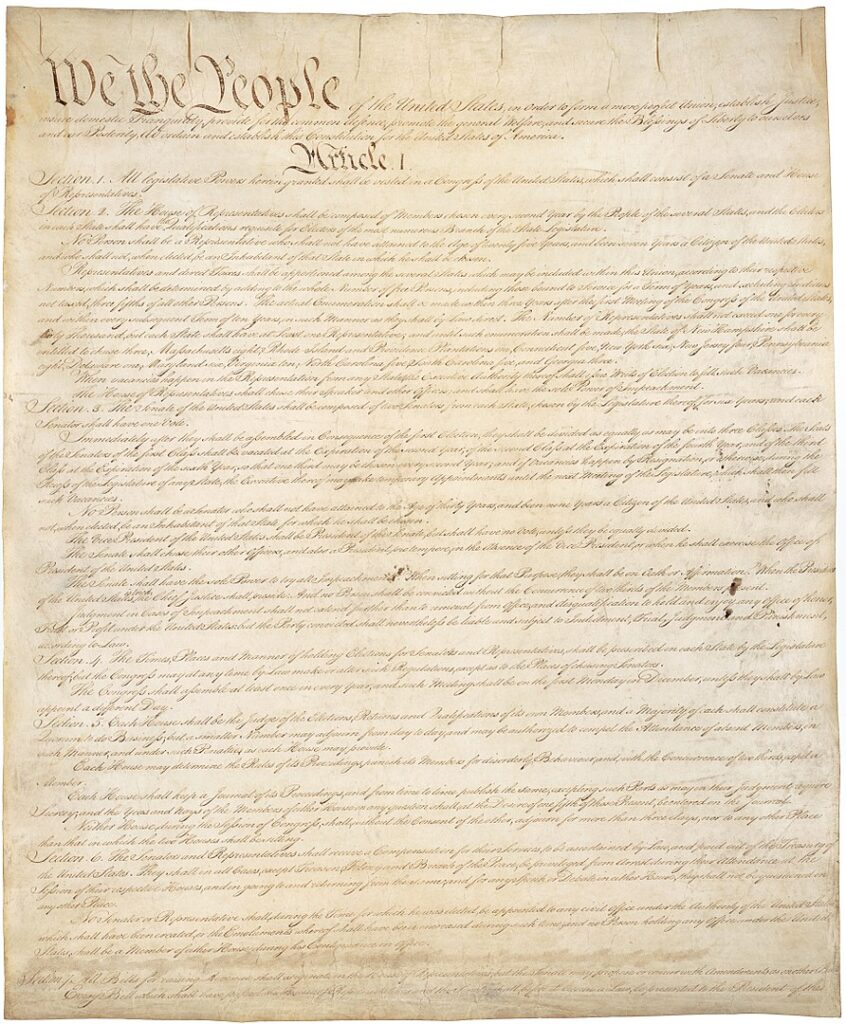Lorem ipsum dolor sit amet, consectetur adipiscing elit. Ut elit tellus, luctus nec ullamcorper mattis, pulvinar dapibus leo.
Need to know ~ Topics & Events
Lorem ipsum dolor sit amet, consectetur ad
The Three Branches of the United States Government

Page 1 of the United States Constitution
Source: U.S. National Archives and Records Administration, Public Domain
Why current?
2020-10-27
Election Day in the United States is not until November 3rd, but millions of Americans have already cast their ballots for either Donald Trump or Joe Biden to serve as president for the next four years. You might be hearing a lot about the elections, and if you live in the U.S., you have probably seen advertisements, telling people to vote for either Biden or Trump. But the presidency is by no means the only important part of the federal government. Senators, representatives, judges, and Supreme Court justices are among the many people who play vital roles in the running of the U.S. government – and what those individuals decide and do can directly affect people’s lives. Senators and representatives are voted into office, just like presidents, and at the ballot box this year, Americans are not only selecting their next president but also members of Congress.
In order to make informed choices, it is important for all of us to know the basic structure of the government. Many terms are being thrown around these days, and “breaking news” headlines are nonstop. Understanding what all the noise is about starts with being clear on what the three branches of government do and how they interact with one another.
More about the three branches of government
Because the Constitution says so.
On September 17, 1787, the delegates at the Constitutional Convention in Philadelphia wrote and signed the United States Constitution. This document was to serve as the highest law of the land. To this day, the government follows that which is stated in the Constitution, although not everyone always agrees on what the original authors meant. One thing was clearly spelled out, though, and that was that there would be three branches of government, and each branch would have certain powers and responsibilities. In addition, the Constitution says that there is to be a system of checks and balances in place, where each branch makes sure neither of the other two branches accumulates too much power.
the legislative branch –
The legislative branch is usually referred to as “Congress.” It is made up of the Senate and the House of Representatives. Citizens of each of the fifty states vote for senators and representatives to represent their state in Congress. Each state elects 2 senators. The number of representatives depends on the population of the state. For example, Alaska only has one representative in Congress because of its small population. California, on the other hand, has 53 because of its large population. There are currently 100 senators and 435 representatives in the U.S. Congress.
The job of the legislative branch is to write and vote on laws. In addition, this branch puts together the budget of the government and has the power to declare war on another country.
the executive branch –
The president is the central figure of the executive branch. He or she has the power to veto (reject) laws passed by Congress. (A presidential veto is not necessarily final, however; it can be overturned by a two-thirds vote in both the House of Representatives and the Senate). The president is also the Commander in Chief of the military and is heavily involved in diplomacy (meaning, negotiating and building relationships with leaders of other countries).
There are many other positions in the executive branch. The Cabinet is made up of a group of people, appointed by the president upon confirmation by the Senate, who head 15 departments that are also part of the executive branch. For example, the Secretary of State is the head of the Department of State, and the Secretary of Education is the head of the Department of Education. Each of these individuals advises the president. The vice president is also a member of the executive branch. He or she must be prepared to take over the presidency, should the president not be able to fulfill his or her duties. The vice president also advises the president and may participate in a vote in the Senate if a tie needs to be broken. The vice president is chosen by the president.
the judicial branch –
The job of the third branch of government – the judicial branch – is to interpret the law. It is made up of the courts, the highest of which is the Supreme Court. Nine justices sit on the Supreme Court. They cannot create laws. They can, however, look at a law and deem it unconstitutional, in which case, that law ceases to exist. The Supreme Court only hears cases that have gone through the lower courts first. The justices on the Supreme Court are nominated by the president and confirmed by the Senate. Once a justice is appointed, he or she has the job for life.
Most recently, President Trump nominated, and the Senate confirmed by a 52-48 vote, Amy Coney Barrett to fill the seat left vacant when Ruth Bader Ginsburg died in September.
Sources: judiciallearningcenter.org, “The Constitution,” https://judiciallearningcenter.org/the-constitution/; law.cornell.edu, “U.S. Constitution,” https://www.law.cornell.edu/constitution/index.html; constitutionfacts.com, “The Constitutional Convention,” https://www.constitutionfacts.com/us-constitution-amendments/the-constitutional-convention/.